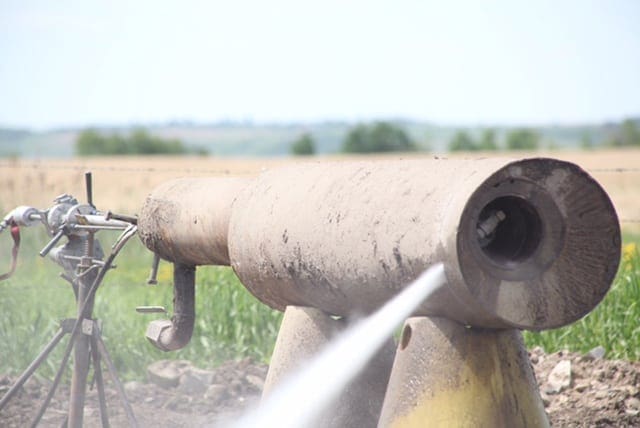Cut-and-cap well abandonment procedures are generally dangerous, time and resource intensive processes relying on cooperative weather, and they become more complicated the worse the weather becomes. A new, innovative technological approach to an old oil and gas problem is to employ a hydro-powered-cutting tool to cut and separate the wellhead while still underground, leaving a small environmental footprint.
High-pressure Water Cuts Though Casing
This hydro tool, mixed with a natural abrasive, cuts into the well casing from the inside. A process that takes only 20 minutes to an hour based on casing layers and cement. The tool fits directly into the well casing and is lowered to the desired separation point. After the precise and quick cutting is finished, the entire casing is pulled out of the ground.
A regulatory approved venting cap is compression fit to the casing strings and seals the well shut. Leaving only a small hole, little backfill is required to cover it. Because there is minimal excavation, there is no slumping around the wellsite months later. Additionally, only two trucks are needed; one fill truck with mini excavator and the cutting tools truck.
This hydro-cutting system is so quick and efficient that the amount of abandonments that can be performed exponentially increases to an average of six—up to nine in good weather—per day. General abandonment methods usually require a full day to cap one well, depending on weather.
Traditional Methods Are Costly and Time Consuming
Using the standard abandonment process, a deep, wide, sloped hole around the wellhead must be excavated to allow access. After excavation, there is a laborious cutting process that entails using a welding torch to cut casings and separate lining cement by hand. Welding requires a hot work permit and in certain situations may place workers in a dangerous environment.
After the well cap is sealed and secured, the large pit around the well must be filled; however, it cannot be backfilled with the same excavated earth. The dirt needs to be removed by truck for cleaning and new fill must be brought in. This process requires the use of five to six trucks to move earth around and equipment costs can run over for several days. Furthermore, this traditional method requires multiple returns to the wellsite over several years to compact and fill in the excavation site due to slumping.
Workers Are Safer, No Flames Required
With a reduced process profile, dangerous situations, such as welding in tight spaces and potential cave-ins, are eliminated. Additionally, there is no exposure to harmful gases or chemicals, as well as no open flame or sparking tools. By using the hydro-cutting tool, dangerous fire hazards are removed from the equation.
Minimize Environmental Footprint
With minimal ground disturbance and no soil contamination from within the well, the hydro-cutting process is environmentally friendly. After the abandonment process, the time it takes for the area to return to its natural state is dramatically reduced.
Wellsites that have used this process have received reclamation certificates within six to eight months — compared with traditional excavation methods, where soil settles and requires backfilling year after year. This refilling prolongs the time it takes to get a reclamation certificate to three to five years—dragging out extra costs during a time when the industry must prevent unnecessary expenditures.
Hydro Cutting Only Provides Benefits
The cut-and-cap abandonment process has been rethought through the use of a hydro-powered cutting tool. This new method expedites the process and reduces equipment and associated costs, while reducing risk to workers and minimizing the effect on the environment. In these times of slashed budgets, the industry needs to optimize its processes or face financial hardship. At your next well abandonment, make the process an afterthought, rather than an ongoing costly challenge.
Tim Sharp is a co-owner of NuWave Industries, Inc. He can be reached at 844-583-3600.





